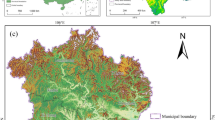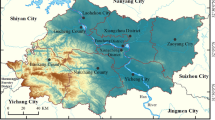Abstract
The research on land use transformation has attracted more and more attention, and there are few research results on the eco-environmental effects of regional land use change from the perspective of land use function transformation. From the perspective of production-living-ecological land use function classification, this paper obtained land use change data of Shaanxi Province in 2000, 2010, and 2020, calculated the land use transfer matrix, ecological environment quality index, and ecological contribution rate of land use transformation, and quantitatively analyzed the temporal and spatial evolution of production-living-ecological spaces and the eco-environmental effects of land use structure transformation in Shaanxi Province. The results showed that the land use change in Shaanxi Province is mainly manifested in the continuous increase of ecological and living land area and the continuous decrease of production land area from 2000 to 2020. In the transformation of land use structure in Shaanxi Province, the biggest change in area is the mutual transformation between productive cultivated land and ecological grassland land. The occupation of ecological grassland land by other land types is an important factor leading to the decline of ecological environment quality. Overall, the ecological environment of Shaanxi Province has shown a trend of improvement in the past two decades. Quantitative research on the transformation characteristics of land use structure and its ecological environment effects in the past two decades is conducive to providing data support for the promotion of ecological civilization construction in Shaanxi Province.


Similar content being viewed by others
Data availability
The datasets used or analyzed during the current study are available from the corresponding author on reasonable request.
References
Abramowicz AK, Rahmonov O, Chybiorz R (2021) Environmental management and landscape transformation on self-heating coal-waste dumps in the Upper Silesian Coal Basin. Land 10(1):23
Amin H, Helmi MM (2021) Impacts of land-use transformation on agriculture land in Afghanistan, Kabul city as case study. Int J Environ Sci Sustain Dev 6(1):52
Asabere SB, Acheampong RA, Ashiagbor G, Beckers SC, Keck M, Erasmi S, Schanze J, Sauer D (2020) Urbanization, land use transformation and spatio-environmental impacts: analyses of trends and implications in major metropolitan regions of Ghana. Land Use Policy 96:104707
Basheer MA, Boelens L, Bijl R (2020) Bus rapid transit system: a study of sustainable land-use transformation, urban density and economic impacts. Sustainability 12(8):3376
Basu T, Das A (2021) Systematic review of how eco-environmental transformation due to urbanization can be investigated in the sustainable development of Indian cities. Environmental Challenges 4:10009
Coetzer KL, Erasmus B, Witkowski E, Reyers B (2013) The race for space: tracking land-cover transformation in a socio-ecological landscape. South Africa Environmental Management 52(3):595–611
Cui J, Zang S (2013) Regional disparities of land use changes and their eco-environmental effects in Harbin-Daqing-Qiqihar Industrial Corridor. Geogr Res 32(5):848–856
Das S, Angadi DP (2020) Land use-land cover (LULC) transformation and its relation with land surface temperature changes: a case study of Barrackpore Subdivision, West Bengal, India. Remote Sensing Applications Society and Environment 19:100322
Deal B, Schunk D (2004) Spatial dynamic modeling and urban land use transformation: a simulation approach to assessing the costs of urban sprawl. Ecol Econ 51(1–2):79–95
Dong Y, Jin G, Deng X (2020) Dynamic interactive effects of urban land-use efficiency, industrial transformation, and carbon emissions. Journal of Cleaner Production 270:122547
Fu G, Chen S, Liu C, Shepard D (2004) Hydro-climatic trends of the yellow river basin for the last 50 years. Clim Change 65(1):149–178
Gang W, Kang H, Zhang X, Shao H, Chu L, Ruan C (2010) A critical review on the bio-removal of hazardous heavy metals from contaminated soils: issues, progress, eco-environmental concerns and opportunities. J Hazard Mater 174(1–3):1–8
Gao X, Liu Z, Li C, Cha L, Song Z, Zhang X (2020) Land use function transformation in the Xiong’an New Area based on ecological-production-living spaces and associated eco-environment effects. Acta Ecol Sin 40(20):7113–7122
Groot RD (2006) Function-analysis and valuation as a tool to assess land use conflicts in planning for sustainable, multi-functional landscapes. Landsc Urban Plan 75(3–4):175–186
Han L, Zhang X, Zhou W, Shen M, Qian Y (2021) Transformation of China’s urbanization and eco-environment dynamics: an insight with location-based population-weighted indicators. Environ Sci Pollut Res 28(4):1–10
Han LF, Xu YP, Shi Y (2012) The effect of land use and land cover change on the stream structure: case study in the Qinhuai River Basin, China. Appl Mech Mater 212–213:186–192
Hitchcock DR, Jayakaran AD, White DL (2014) Green infrastructure in coastal landscapes: ecological design, hydrological function, and sustainable land use goals. Journal of South Carolina Water Resources 1(1):35–39
Huang Y, Hui E, Zhou J, Lang W, Li X (2020) Rural revitalization in China: land-use optimization through the practice of place-making. Land Use Policy 97:104788
Lax SM, Peterson EW, Van D (2017) Stream chloride concentrations as a function of land use: a comparison of an agricultural watershed to an urban agricultural watershed. Environmental Earth Sciences 76(20):708
Liu LC, Dong XF, Wang JH (2007) Dynamic analysis of eco-environmental changes based on remote sensing and geographic information system: an example in Longdong region of the Chinese Loess Plateau. Environ Geol 53(3):589–598
Lorenzen M, Orozco-Ramírez Q, Ramírez-Santiago R, Garza GG (2020) Migration, socioeconomic transformation, and land-use change in Mexico’s Mixteca Alta: lessons for forest transition theory. Land Use Policy 95:104580
Mumtaz F, Tao Y, Leeuw GD, Zhao L, Wang D (2020) Modeling spatio-temporal land transformation and its associated impacts on land surface temperature (lst). Remote Sensing 12(18):2987
Niu J, Du H (2021) Coordinated development evaluation of population–land–industry in counties of western China: a case study of Shaanxi province. Sustainability 13(4):1983
Qiang L, Yang Z, Cui B (2008) Spatial and temporal variability of annual precipitation during 1961–2006 in Yellow River Basin. China Journal of Hydrology 361(3–4):330–338
Rerkasem K, Yimyam N, Rerkasem B (2009) Land use transformation in the mountainous mainland southeast Asia region and the role of indigenous knowledge and skills in forest management. For Ecol Manage 257(10):2035–2043
Sanchez PA, Leakey R (1997) Land use transformation in Africa: three determinants for balancing food security with natural resource utilization. Eur J Agron 7(1):15–23
Vivcharenko, O. A. . (2019). Land use and protection control of Ukraine: control function. Actual problems of improving of current legislation of Ukraine(50), 114–119.
Wang H (2021) The impact of shale oil and gas development on rangelands in the permian basin region: an assessment using high-resolution remote sensing data. Remote Sens 13(4):824
Wang L, Wu L, Zhang W (2021a) Impacts of land use change on landscape patterns in mountain human settlement: the case study of Hantai district (Shaanxi, China). J Mt Sci 18(3):749–763
Wang S, Padmanaban R, Mbanze AA, Silva J, Campos FS (2021b) Using satellite image fusion to evaluate the impact of land use changes on ecosystem services and their economic values. Remote Sensing 13(5):851
Wang SY, Liu JS, Ma TB (2010) Dynamics and changes in spatial patterns of land use in Yellow River Basin. China Land Use Policy 27(2):313–323
Wang, X. , Chen, D. , Pang, G. , Gou, X. , & Yang, M. . (2021). Historical and future climates over the upper and middle reaches of the Yellow River Basin simulated by a regional climate model in cordex. Climate Dynamics, 1–23.
Wei, X. , Wang, N. , Luo, P. , Yang, J. , Zhang, J. , & Lin, K. . (2021). Spatiotemporal assessment of land marketization and its driving forces for sustainable urban–rural development in Shaanxi province in China. Sustainability, 13.
Wen-Bo WU, Jing Y, Ting-Jun K (2008) Study on land use changes of the coal mining area based on TM image. Journal of Coal Science & Engineering 14(002):287–290
Wynn, J. G. , Duvert, C. , Bird, M. I. , Munksgaard, N. C. , Setterfield, S. A. , & Hutley, L. B. . (2020). Land transformation in tropical savannas preferentially decomposes newly added biomass, whether c3 or c4 derived. Ecological Applications, 30(8).
Yang J, Yang R, Chen MH, Su J, Xi J (2021) Effects of rural revitalization on rural tourism. J Hosp Tour Manag 47(4):35–45
.Yang, J., Guo, A., Li, Y., Zhang, Y., Li, X.(2019). Simulation of landscape spatial layout evolution in rural-urban fringe areas: a case study of Ganjingzi District, GIScience & Remote Sensing, 56 (3): 388-405
Yang, J., Liu, W., Li Y., Li X., Ge Q. (2018). Simulating intraurban land use dynamics under multiple scenarios based on fuzzy cellular automata: a case study of Jinzhou district, Dalian. Complexity, 7202985, https://doi.org/10.1155/2018/7202985
Yang J, Xie P, Xi J, Ge Q, Ma Z (2015) LUCC simulation based on the cellular automata simulation: a case study of Dalian economic and technological development zone. Acta Geogr Sin 70(3):461–475
Yang Y, Bao W, Liu Y (2020) Coupling coordination analysis of rural production-living-ecological space in the Beijing-Tianjin-Hebei region. Ecological Indicators 117(4):106512
Yang Z, Li C (2020) Spatial and temporal characteristics of rurality in urban suburb town and its driving factors based on land use transformation. Complexity 2020(4):1–10
Yao Z, Tian L (2020) How did collectivity retention affect land use transformation in peri-urban areas of China? A case of Panyu. Guangzhou Journal of Rural Studies 79(13):1–10
Yin, Z. , Y Liu, & Y Pan. (2021). Evaluation and classification of rural multifunction at a grid scale: a case study of Miyun district, Beijing. Sustainability, 13.
Zhang Q, Chen Z, Li F (2021a) Appropriate management scale of farmland and regional differences under different objectives in Shaanxi province. China Land 10(3):1–15
Zhang, Z. , Chang, T. , Qiao, X. , Yang, Y. , Guo, J. , & Zhang, H. . (2021). Eco-economic coordination analysis of the Yellow River Basin in China: insights from major function-oriented zoning. Sustainability, 13.
Zhao D, Wang J, Zhao X, Triantafilis J (2022) Clay content mapping and uncertainty estimation using weighted model averaging. Catena 209:105791
Zhao D, Zhao X, Khongnawang T, Arshad M, Triantafilis J (2018) A Vis-NIR spectral library to predict clay in Australian cotton growing soil. Soil Sci Soc Am J 82(6):1347–1357
Zhao, X. , Calvin, K. V. , & Wise, M. A. . (2020). The critical role of conversion cost and comparative advantage in modeling agricultural land use change. Climate Change Economics (CCE), 11.
Funding
This work was supported by Shaanxi Province Soft Science Research Project (Grant nos. 2021KRM093), Joint Project of Major Theoretical and Practical Problems in the Social Sciences of Shaanxi Province (Grant nos. 20ST-98), Joint Project of Major Theoretical and Practical Problems in the Social Sciences of Shaanxi Province (Grant nos. 2021HZ0540), Social Science Fund of Shaanxi Province (Grant nos. 2020R051), and Xi’an University of Architecture and Technology Humanities and Social Sciences Special Project (Grant nos. SK20014; ZR20074).
Shaanxi Province Soft Science Research Project,2021KRM093,Chenxi Li,Joint Project of Major Theoretical and Practical Problems in the Social Sciences of Shaanxi Province,20ST-98,Chenxi Li,Social Science Fund of Shaanxi Province,2020R051,Chenxi Li
Author information
Authors and Affiliations
Contributions
Chenxi Li and Jingyao Wu contributed to the conception of the study; Chenxi Li performed the experiment; Jingyao Wu contributed significantly to analysis and manuscript preparation; Chenxi Li performed the data analyses and wrote the manuscript; and Jingyao Wu helped perform the analysis with constructive discussions.
Corresponding author
Ethics declarations
Ethics approval
Not applicable.
Consent to participate
Not applicable.
Consent for publication
Not applicable.
Conflict of interest
The authors declare no competing interests.
Additional information
Responsible Editor : Philippe Garrigues.
Publisher's note
Springer Nature remains neutral with regard to jurisdictional claims in published maps and institutional affiliations.
Rights and permissions
About this article
Cite this article
Li, C., Wu, J. Land use transformation and eco-environmental effects based on production-living-ecological spatial synergy: evidence from Shaanxi Province, China. Environ Sci Pollut Res 29, 41492–41504 (2022). https://doi.org/10.1007/s11356-022-18777-z
Received:
Accepted:
Published:
Issue Date:
DOI: https://doi.org/10.1007/s11356-022-18777-z




